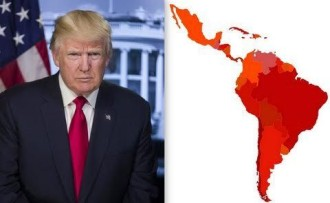Mexico could be the surprise star despite Trump rhetoric. Read more on this article that appeared in Latinvex written by Walter T. Milano.
With President Donald Trump sitting in the White House, many people are asking what lies in store for Latin America.
The attitude of the U.S. towards the region for the past three decades has been mainly one of benign neglect. This hands off approach allowed it to develop politically and economically. It enjoys the trappings of democracy, with a few exceptions. The economies are relatively sound, but they are highly vulnerable to external changes. It is hard to imagine that the benign neglect attitude of the U.S. government will end with President Trump, even though he has a number of important property investments throughout the region.
Nevertheless, it will be affected as the Fed embarks on a new phase of monetary tightening. A massive fiscal stimulus, an overheating economy and demographic change will put upward pressure on U.S. inflationary forces. As a result, yields will rise and several asset markets, such as equities, commodities and real estate, will rally. A similar trend, albeit with less vigor, will occur in Europe, reducing the demand for the emerging market instruments. We must recall that the emerging markets are an alternative asset class. They are a substitute for when the core markets face challenges, as they did after the financial crisis, when interest rates were extremely low and GDP growth rates were abysmal. With the U.S. economy poised to grow more than 4 percentin 2017 and rates moving higher, investors are moving back to more familiar terrain.
This will create severe challenges for Latin America, but particularly for the countries and companies that are more dependent on the international capital markets. Top of the list are serial issuers, such as Argentina, Pemex and Petrobras. All three scurried to the market as soon as they could before investor sentiment changed. Like a recovering alcoholic who just downed his first shot of whiskey in 12 years, Argentina has plunged off the wagon. It has issued more than $10 billion since the start of the year, and it still has $30 billion to go before year-end.
ANDEAN IMPACT
High grade issuers, particularly the Andeans, will see rising yields, due to the increase in Treasury rates, but could see their spreads contract due to better export earnings. The devaluations of their currencies boosted their competitiveness. The stronger dollar is a boom to Latin American exporters, many of whom have suffered from over-valued exchange rates for almost a decade. Commodity prices will also move higher as global aggregate demand expands. With the U.S. and China growing at almost the same pace, there will be greater demand for raw materials. Declining commodity output due to years of weak capex will surely keep raw material prices high, thus improving the credit worthiness of many Latin American countries. Venezuela will be the outlier. It will continue to suffer from internal political and social unrest. Fortunately, improving oil prices will ease some of the pressure on PDVSA and the government. We believe that oil prices will end the year above $60 per barrel, thus providing the country with a significant boost. We do not believe that it will default in 2017, but the political drama will continue. Brazil will be in a similar situation, due to its ongoing political problems. Still, the improving trend in inflation, the external accounts and fiscal policy could make Brazil one of the better performers in 2017.
MEXICO: SURPRISE STAR?
However, the unexpected star in 2017 could be Mexico. Despite the rhetoric from the White House, the Mexican economy will benefit from the economic revival of the U.S. The correlation of GDP growth between the two countries since 2007 has been about 80%. Back in 1991, when NAFTA was signed, the correlation was 18%. However, it took decades for U.S. manufacturers to move some of their capacity south.
Today, Mexico is an integral part of the U.S. industrial base. Hence, the expansion in U.S. economic activity will surely be felt south of the border. Most of the companies that announced changes to their Mexican investment plans were part of the small universe of firms that received government bin the past, such as Chrysler and General Motors, or depend heavily on government contracts, such as Carrier/United Technologies. It is only natural that they kowtow to the new powers in Washington.
Still, the larger set of corporations that are not as dependent on government assistance or projects will continue to operate unabatedly, and provide a strong boost to the Mexican economy. In other words, there will be winners and losers in 2017, but Mexico could be holding the proverbial Trump card.
Walter Molano is head of research at BCP Securities and the author of In the Land of Silver: 200 Years of Argentine Political-Economic Development.
